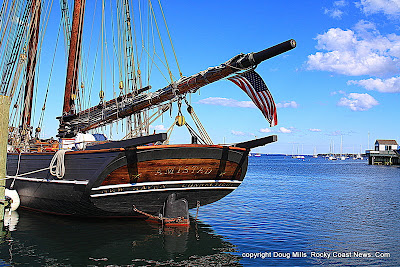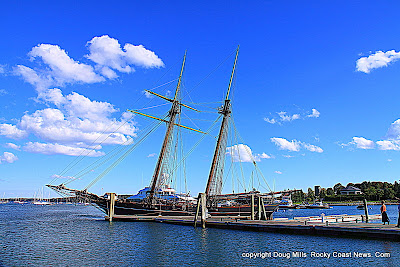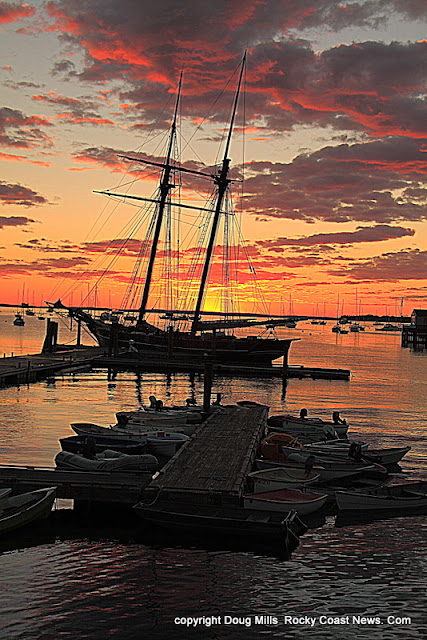The MaineSail Journal
Amastad
By Doug Mills
 Fall brings many surprises to the
coast of Maine. A very pleasant surprise was to find Captain Sean
Bercaw of Freedom Schooner Amistad, awaiting customs clearance after
returning from Nova Scotia. Amistad is a ship with a mission. A
reminder of a dark time in history when people were stolen from their
homes and carried off to a far away land where no one spoke their
language and they were forced into a life of slavery. Her namesake
La Amistad was transporting 53 slaves to Cuba to be used as labor in
the sugar cane fields when she was forced to change course and this
eventually helped to change the course of this nation. During to
voyage to Cuba one of the slaves was able to free himself and also
the others who were on board. Armed with sugar cane knives the
managed to take the ship. They ordered the crew to sail west, which
they did during the day but at night they would sail north east in
hope of running across another vessel to free them from the slaves
who held the ship. Off Long Island New York the U S Navy ship USS
Washington found them and took the slaves into custody and took
possession of La Amistad.
Fall brings many surprises to the
coast of Maine. A very pleasant surprise was to find Captain Sean
Bercaw of Freedom Schooner Amistad, awaiting customs clearance after
returning from Nova Scotia. Amistad is a ship with a mission. A
reminder of a dark time in history when people were stolen from their
homes and carried off to a far away land where no one spoke their
language and they were forced into a life of slavery. Her namesake
La Amistad was transporting 53 slaves to Cuba to be used as labor in
the sugar cane fields when she was forced to change course and this
eventually helped to change the course of this nation. During to
voyage to Cuba one of the slaves was able to free himself and also
the others who were on board. Armed with sugar cane knives the
managed to take the ship. They ordered the crew to sail west, which
they did during the day but at night they would sail north east in
hope of running across another vessel to free them from the slaves
who held the ship. Off Long Island New York the U S Navy ship USS
Washington found them and took the slaves into custody and took
possession of La Amistad.
The
court case that followed was instrumental in bringing the blight of
slavery into the public eye in the United States. The case went all
the way to the Supreme Court who freed the those who had been
involved in the taking of La Amistad. They eventually were able to
return to their home but things had changed forever in the United
States due to the actions of these former slaves.
“The
impetus for building the Amistad came from Warren Q. Marr II, former
editor of the NAACP’s The Crisis magazine. Marr’s inspiration for
the replica emerged during New York’s operation sail 1976, a
spectacular parade of the world’s tall ships. Participating in that
event was a representation of the historic 19th century schooner, La
Amistad. It was actually the schooner Western Union with its name
temporarily hidden under signs proclaiming her La Amistad. Marr
wanted the story of the African captives’ fight for freedom on the
seas, in a New Haven court, and in a landmark United States Supreme
Court case to be told. Marr’s goal was to design the re-created
vessel as a floating exhibit, assemble a crew, and sail her from port
to port teaching the history of the Amistad Incident of 1839. Marr
believed the Amistad story could foster unity among people of diverse
backgrounds and help improve race relations.”
“The
reproduction was built in Mystic Seaport’s Henry B. DuPont
Preservation Shipyard. It was built using traditional construction
techniques. Some of the tools used to construct the Freedom Schooner
Amistad were those that may have been used in 19th century
construction. Others were electric tools. The reconstruction, while
based on the appearance of La Amistad was about 10 feet longer than
the original to accommodate an engine room. It also had bronze bolts
in use as fastenings throughout the ship and an external ballast made
of lead. None of these features would have been available on the
original Amistad.”
The
dimensions of the Amistad are as follows:
 1.
Length from bowsprit to stern: 129 ft (39.4 m)
1.
Length from bowsprit to stern: 129 ft (39.4 m)2. Length Over Rail: 85 ft (26 m)
3. Length On Deck: 81 ft (24.7 m)
4. Maximum Beam (Width): 23 ft (7.01 m)
5. Length at Waterline: 78 ft (23.8 m)
6. Draft (depth): 10.5 ft (3.3 m)
7. Height of masts: 100 ft (30.5 m)
[AAI
Staff. "Frequently Asked Questions (FAQ)." AMISTAD America.
AMISTAD America Inc, 14 Jan. 2008. Web. 7 May 2009..]
















No comments:
Post a Comment